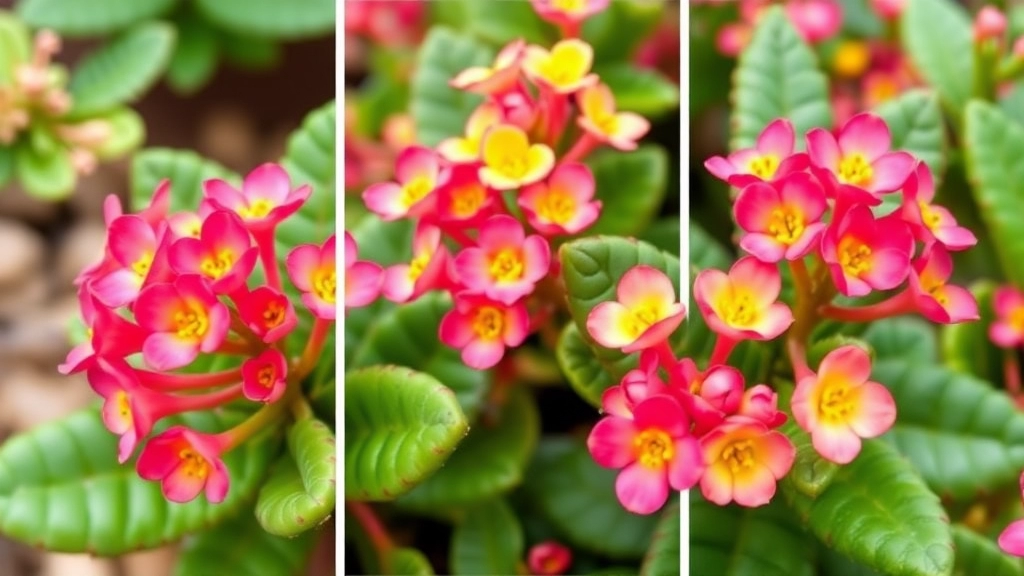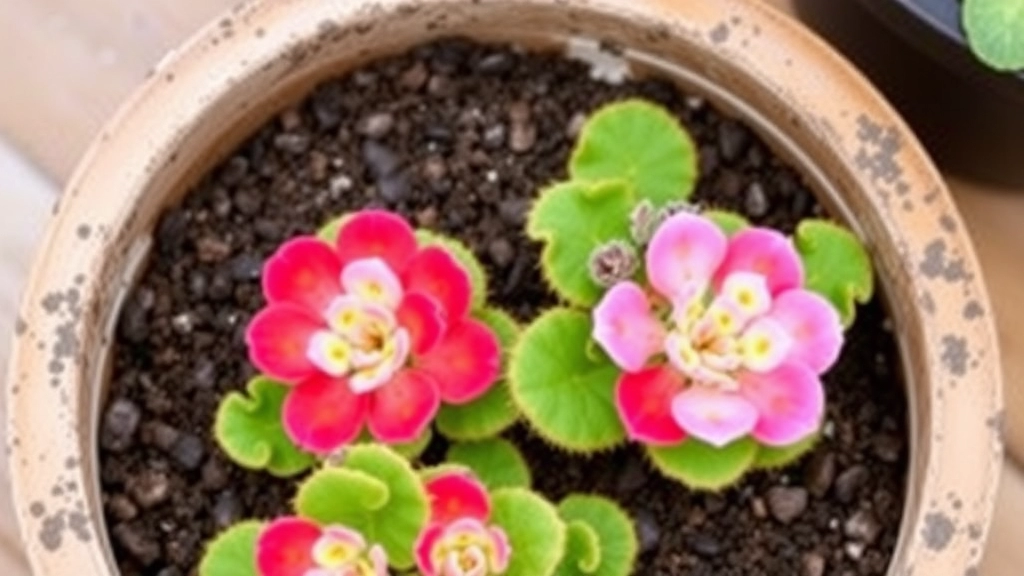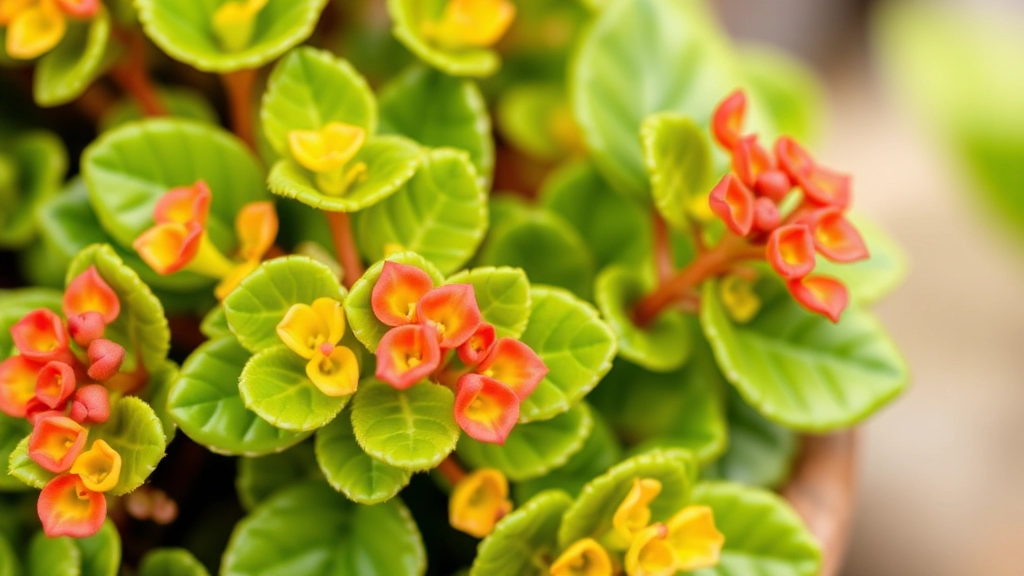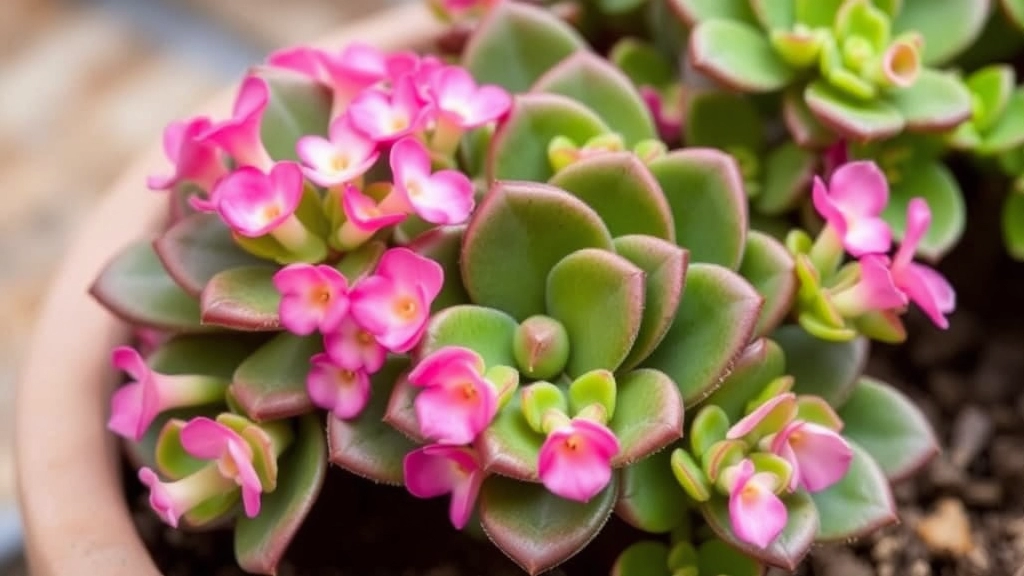Is Kalanchoe a Succulent?
Wondering if Kalanchoe is a succulent? You’re in the right place. Yes, Kalanchoe is indeed a succulent, known for its thick, fleshy leaves that store water. This unique feature makes it a popular choice among plant enthusiasts who appreciate low-maintenance greenery. But there’s more to Kalanchoe than just its succulent nature.
What Makes Kalanchoe Stand Out?
Let’s dive into what makes Kalanchoe stand out among other succulents. From its vibrant blooms to its easy propagation methods, Kalanchoe offers a lot to love. Whether you’re a seasoned plant parent or a newbie, understanding the optimal growing conditions and care tips for Kalanchoe can help you keep your plant thriving. So, let’s explore how to give your Kalanchoe the best care possible.
Are you curious about what sets Kalanchoe apart as a succulent?
Kalanchoe is a fascinating member of the succulent family, renowned for its unique adaptations that enable it to thrive in arid environments.
Key Characteristics of Kalanchoe Succulents:
– **Water Storage:** Kalanchoe plants have thick, fleshy leaves that store water, allowing them to withstand periods of drought. This is a defining feature of all succulents.
– **Photosynthesis Adaptation:** They utilize a special form of photosynthesis known as Crassulacean Acid Metabolism (CAM), which helps them conserve water by opening their stomata at night instead of during the day.
– **Variety of Shapes and Sizes:** Kalanchoe comes in various shapes, sizes, and colours, making them popular for decorative purposes. Some species even produce vibrant flowers that can brighten up any space.
– **Drought Tolerance:** These plants are incredibly resilient and can survive in less-than-ideal conditions, making them perfect for both beginners and seasoned gardeners.
In essence, Kalanchoe’s ability to store water and adapt to its environment makes it a quintessential succulent. For more detailed information on caring for these fascinating plants, check out our [complete care guide for Kalanchoe Blossfeldiana](https://planthq.org/complete-care-guide-for-kalanchoe-blossfeldiana-succulent/) and learn about the [health benefits of Kalanchoe Pinnata juice](https://planthq.org/health-benefits-of-kalanchoe-pinnata-juice/).
Common Kalanchoe Species and Their Unique Features

So, you’ve got a Kalanchoe and you’re curious about the different types? You’re not alone! These charming succulents come in a variety of species, each with its own quirks and characteristics. Let’s dive into some of the most popular Kalanchoe species that you might want to consider adding to your collection.
1. Kalanchoe blossfeldiana
- Appearance: This is the classic Kalanchoe you often see in garden centres. It has thick, waxy leaves and produces clusters of vibrant flowers.
- Flowers: They bloom in various colours, including red, pink, yellow, and white.
- Care Tip: Keep it in bright, indirect light for the best blooms.
2. Kalanchoe tomentosa (Panda Plant)
- Appearance: Known for its fuzzy, grey-green leaves with brown edges, this one’s a real eye-catcher.
- Unique Feature: The leaves resemble panda ears, hence the name!
- Care Tip: Likes a bit of neglect, so don’t overwater.
3. Kalanchoe luciae (Flapjack Plant)
- Appearance: These are flat, paddle-shaped leaves that turn a stunning red in bright sunlight.
- Unique Feature: The colour change is a sign of healthy stress—how cool is that?
- Care Tip: Perfect for outdoor gardens, just ensure they get plenty of sun.
4. Kalanchoe fedtschenkoi (Mother of Thousands)
- Appearance: This one is a bit wild, with long, trailing stems and small plantlets that grow along the edges of the leaves.
- Unique Feature: It’s like a mini propagation factory!
- Care Tip: Keep it in a pot where it can trail freely.
5. Kalanchoe beharensis (Elephant Ear)
- Appearance: This species features large, thick leaves that can grow quite tall.
- Unique Feature: The leaves have a unique texture, almost like they’re covered in felt.
- Care Tip: Give it room to grow; it can become quite a statement piece.
These Kalanchoe species each bring something special to the table, whether it’s their stunning flowers or unique leaf shapes.
Optimal Growing Conditions for Kalanchoe Succulents
When considering how to nurture your Kalanchoe succulents, it’s essential to understand their optimal growing conditions.
Light Requirements
Kalanchoe thrives in bright, indirect sunlight.
- Ideal Location: A south or west-facing window is perfect.
- Duration: Aim for about 6 hours of light daily.
- Signs of Insufficient Light: If your Kalanchoe becomes leggy or its leaves lose colour, it may need more light.
Temperature Preferences
Kalanchoe is sensitive to extreme temperatures.
- Ideal Range: They prefer temperatures between 18°C to 24°C.
- Cold Sensitivity: Protect them from frost; temperatures below 10°C can be detrimental.
Humidity Needs
Kalanchoe succulents are not fans of high humidity.
- Optimal Humidity: A dry environment is best; aim for below 50% humidity.
- Indoor Conditions: Most homes naturally provide the right humidity levels.
Fertilisation
Feeding your Kalanchoe correctly can boost growth.
- Frequency: Fertilise every 4-6 weeks during the growing season (spring and summer).
- Type of Fertiliser: Use a diluted, balanced fertiliser or one specifically for succulents.
Air Circulation
Good airflow is crucial for Kalanchoe health.
Watering and Soil Requirements for Healthy Kalanchoe Growth

When it comes to nurturing your Kalanchoe succulents, understanding their watering and soil needs is crucial for their overall health. Many enthusiasts find themselves puzzled about how much water these resilient plants truly require.
Watering Guidelines
Kalanchoes are succulents, meaning they store water in their leaves and stems. This unique adaptation allows them to thrive in arid conditions. However, overwatering can lead to root rot, a common issue for many succulent owners. Here are some straightforward tips for watering your Kalanchoe:
- Frequency: Water every 2-3 weeks during the growing season (spring and summer). Reduce this to once a month in the dormant months (autumn and winter).
- Soil Dryness: Always check the soil before watering. Insert your finger about an inch deep; if it feels dry, it’s time to water.
- Watering Technique: Water thoroughly until it drains out of the bottom. Ensure you discard any excess water that collects in the saucer.
Soil Requirements
The right soil is just as important as the watering routine. Kalanchoes prefer a well-draining mix that mimics their natural habitat. Consider the following:
- Potting Mix: Use a commercial cactus or succulent mix, or create your own by mixing potting soil with sand or perlite.
- pH Level: Aim for a slightly acidic to neutral pH (around 6.0 to 7.0) for optimal growth.
- Container Choice: Ensure your pot has drainage holes to prevent water accumulation.
By following these watering and soil guidelines, you will create an environment where your Kalanchoe can flourish.
How to Propagate Kalanchoe Succulents Successfully
Many plant enthusiasts wonder how to expand their Kalanchoe collection without breaking the bank. Propagation is a rewarding process that allows you to create new plants from existing ones, ensuring your garden or indoor space thrives.
Methods of Propagation
There are a few straightforward methods to propagate Kalanchoe succulents:
- Leaf Cuttings:
- Select a healthy leaf from the parent plant.
- Cut the leaf at the base using a clean, sharp knife.
- Allow the cut end to dry for a few days until a callous forms.
- Place the leaf in well-draining soil, ensuring it’s upright.
- Water sparingly until roots develop.
- Stem Cuttings:
- Choose a healthy stem and cut it just below a node.
- Remove the lower leaves to expose the stem.
- Let the cutting dry for a couple of days to form a callous.
- Plant the cutting in a suitable potting mix.
- Water lightly and wait for roots to establish.
- Offsets:
- Some Kalanchoe species produce offsets, or “pups,” around the base.
- Gently separate these pups from the parent plant.
- Replant them in their own pots with well-draining soil.
- Water lightly to encourage root growth.
Tips for Successful Propagation
- Timing: The best time to propagate Kalanchoe is during the growing season, typically spring or early summer.
- Environment: Ensure the cuttings are placed in a warm, bright location but avoid direct sunlight to prevent scorching.
- Humidity: A humid environment can aid root development. Consider using a plastic bag to create a mini greenhouse effect, but ensure proper airflow to avoid rot.
By following these methods, you’ll not only save money but also enjoy the satisfaction of nurturing new life. For more detailed instructions, check out our step-by-step guide on propagating Kalanchoe Tomentosa. Additionally, if you’re looking to expand your collection, learn how to grow Kalanchoe from seeds in our comprehensive seed growing guide.
Managing Pests and Diseases in Kalanchoe

So, you’ve got your Kalanchoe thriving, but now you’re worried about pests and diseases creeping in, right? Don’t stress; I’ve been there too. Kalanchoe succulents can be pretty resilient, but like any plant, they can face a few challenges.
Common Pests to Watch For
- Mealybugs: These little white fluff balls love to hide in the nooks of your plant.
- Aphids: Tiny green or black bugs that suck the sap from your Kalanchoe.
- Spider Mites: They’re super small and can create fine webbing on your leaves.
Signs of Trouble
- Yellowing leaves?
- Wilting despite proper watering?
- Sticky residue on your plant?
These could be signs of pest trouble or disease lurking around.
Quick Fixes
- Manual Removal: For mealybugs, a cotton swab dipped in alcohol can do wonders.
- Neem Oil: A natural pesticide that works wonders for most pests. Just mix it with water and spray.
- Insecticidal Soap: This can help tackle aphids and spider mites without harming your plant.
Preventive Measures
- Keep It Clean: Regularly wipe down leaves to remove dust and potential pests.
- Good Air Circulation: Avoid overcrowding your Kalanchoe with other plants.
- Check New Plants: Always inspect new additions to your plant family to avoid bringing in pests.
Diseases to Be Aware Of
- Root Rot: Overwatering can lead to this nasty disease.
- Powdery Mildew: A white powdery substance on leaves usually indicates high humidity.
Treatment Tips
- Root Rot: If you suspect this, remove the plant from its pot, trim away rotten roots, and repot in fresh, dry soil.
- Powdery Mildew: A mix of baking soda and water can help combat this. Spray it on affected areas.
Taking care of your Kalanchoe is like looking after a good friend—you want to keep them healthy and happy!
Seasonal Care Tips for Kalanchoe Indoors and Outdoors
As we dive into the seasonal care of Kalanchoe, it’s essential to understand how these succulents respond to changing conditions throughout the year.
Spring: Awakening Growth
Spring is the perfect time to give your Kalanchoe some extra attention as it comes out of dormancy.
- Light: Ensure they receive bright, indirect sunlight for optimal growth.
- Fertilisation: Start using a diluted succulent fertiliser every four to six weeks.
- Repotting: Consider repotting if the plant has outgrown its container.
Summer: Thriving in Warmth
During summer, Kalanchoe loves the warmth, but it’s crucial to monitor their hydration levels.
- Watering: Water more frequently, allowing the soil to dry out between waterings.
- Shade: Provide some afternoon shade if the heat becomes intense.
- Pest Checks: Regularly inspect for pests like mealybugs or spider mites.
Autumn: Preparing for Dormancy
As autumn approaches, your Kalanchoe will start to slow down.
- Light: Gradually reduce direct sunlight exposure.
- Watering: Cut back on watering as the temperatures drop.
- Pruning: Trim any dead leaves or spent flowers to encourage new growth.
Winter: Careful Management
Winter can be challenging for Kalanchoe, especially indoors.
FAQs About Kalanchoe Succulents
Is Kalanchoe a Succulent?
Yes, Kalanchoe is a type of succulent. These plants store water in their leaves and stems, allowing them to thrive in arid conditions.
What Are Some Common Species of Kalanchoe?
There are several popular species of Kalanchoe, each with unique features:
- Kalanchoe blossfeldiana: Known for its thick, waxy leaves and vibrant flowers.
- Kalanchoe tomentosa (Panda Plant): Recognized by its fuzzy, grey-green leaves with brown edges.
- Kalanchoe luciae (Flapjack Plant): Features flat, paddle-shaped leaves that turn red in bright sunlight.
- Kalanchoe fedtschenkoi (Mother of Thousands): Has long, trailing stems and small plantlets along the leaf edges.
- Kalanchoe beharensis (Elephant Ear): Large, thick leaves with a unique texture.
How Often Should I Water My Kalanchoe?
Kalanchoes should be watered every 2-3 weeks during the growing season (spring and summer) and once a month in the dormant months (autumn and winter). Always check the soil before watering; if it feels dry an inch deep, it’s time to water.
What Type of Soil Is Best for Kalanchoe?
Kalanchoes prefer a well-draining soil mix. A commercial cactus or succulent mix works well, or you can create your own by mixing potting soil with sand or perlite. Aim for a slightly acidic to neutral pH (around 6.0 to 7.0).
How Can I Prevent Pests and Diseases in My Kalanchoe?
To prevent pests and diseases, keep your Kalanchoe clean, ensure good air circulation, and inspect new plants before introducing them to your collection. If pests do appear, neem oil or insecticidal soap can be effective treatments.
What Are Common Pests That Affect Kalanchoe?
Common pests include mealybugs, aphids, and spider mites. Signs of pest trouble include yellowing leaves, wilting despite proper watering, and sticky residue on the plant.
How Do I Treat Root Rot in My Kalanchoe?
If you suspect root rot, remove the plant from its pot, trim away rotten roots, and repot it in fresh, dry soil. Avoid overwatering to prevent root rot.
Can Kalanchoe Be Grown Outdoors?
Yes, many Kalanchoe species can be grown outdoors, especially in regions with plenty of sunlight. For example, Kalanchoe luciae (Flapjack Plant) thrives in outdoor gardens with ample sun exposure.
What Are Some Unique Features of Kalanchoe Plants?
Kalanchoe plants are known for their unique features such as vibrant flowers, fuzzy leaves, and interesting leaf shapes. For instance, the Kalanchoe tomentosa (Panda Plant) has leaves that resemble panda ears.
How Can I Encourage My Kalanchoe to Bloom?
To encourage blooming, place your Kalanchoe in bright, indirect light and follow a proper watering schedule. Kalanchoe blossfeldiana, for example, blooms best with adequate light and care.
References
-
The Spruce – Growing Kalanchoe Succulents
-
Gardening Know How – Kalanchoe Plant Care
-
The Old Farmer’s Almanac – Kalanchoe
